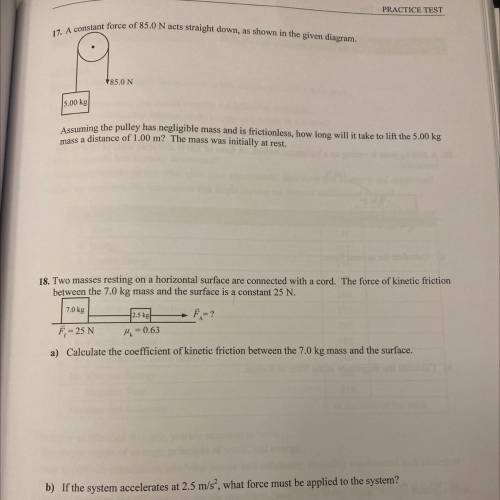Need help on these 2 an explanation of what formula’s to use would also be appreciated
...


Answers: 3


Other questions on the subject: Physics

Physics, 21.06.2019 13:50, georgesarkes12
If jill was traveling at 300 miles in 4 hours due south what was his velocity in miles per minute a) 75 miles per hour due south b) .02 miles per second due south c) .5 miles per second due south d) 1 mile per hour due south
Answers: 2

Physics, 22.06.2019 03:30, nkazmirski5598
Aplane flies a distance d from west to east at a constant speed vp , with respect to the air in a time twe . on the return trip, the plane flies a distance d from east to west at a constant speed vp , with respect to the air in a time tew . on both trips the wind blows from west to east at a constant speed va , with respect to the ground 1) what is tew in terms of vp, va, and d, as needed? tew=dvp tew=dvp+va tew=dva tew=dvpâ’va tew=12dvp tew=12dvp+va tew=12dvpâ’va your submissions: b submitted: saturday, january 26 at 6: 49 pm feedback: feedback will be given once all questions have been attempted and the grade cluster button has been pressed. 2) what is twe in terms of vp, va, and d, as needed? twe=dvp twe=dvp+va twe=dva twe=dvpâ’va twe=12dvp twe=12dvp+va twe=12dvpâ’va your submissions: d submitted: saturday, january 26 at 6: 49 pm feedback: feedback will be given once all questions have been attempted and the grade cluster button has been pressed. 3) assuming d = 2300 miles, vp = 400 miles/hr, and twe = 4 hours, what is va, the speed of the wind with respect to the ground? va = 100 miles/hr va = 575 miles/hr va = 200 miles/hr va = 175 miles/hr va = 975 miles/hr 4) once again, assuming d = 2300 miles, vp = 400 miles/hr, and twe = 4 hours, what is tew, the time it takes the plane to fly a distance d miles from east to west? tew = 5.75 hours tew = 11.5 hours tew = 7.67 hours tew = 8 hours tew = 10.2 hours
Answers: 2

Physics, 22.06.2019 06:00, jagmeetcheema
The frequency of vibrations of a vibrating violin string is given by f = 1 2l t ρ where l is the length of the string, t is its tension, and ρ is its linear density.† (a) find the rate of change of the frequency with respect to the following. (i) the length (when t and ρ are constant) (ii) the tension (when l and ρ are constant) (iii) the linear density (when l and t are constant) (b) the pitch of a note (how high or low the note sounds) is determined by the frequency f. (the higher the frequency, the higher the pitch.) use the signs of the derivatives in part (a) to determine what happens to the pitch of a note for the following. (i) when the effective length of a string is decreased by placing a finger on the string so a shorter portion of the string vibrates df dl 0 and l is ⇒ f is ⇒ (ii) when the tension is increased by turning a tuning peg df dt 0 and t is ⇒ f is ⇒ (iii) when the linear density is increased by switching to another string df dρ 0 and ρ is ⇒ f is ⇒
Answers: 3

Physics, 22.06.2019 12:20, drewefielder6198
Which of the following situations is impossible? a) an object has velocity directed east and acceleration directed east. b) an object has zero velocity but non-zero acceleration. c) an object has constant non-zero velocity and changing acceleration. d) an object has velocity directed east and acceleration directed west. e) an object has constant non-zero acceleration and changing velocity.
Answers: 2
You know the right answer?
Questions in other subjects:

Mathematics, 19.10.2021 14:00



Mathematics, 19.10.2021 14:00



Mathematics, 19.10.2021 14:00

Mathematics, 19.10.2021 14:00


Social Studies, 19.10.2021 14:00






















